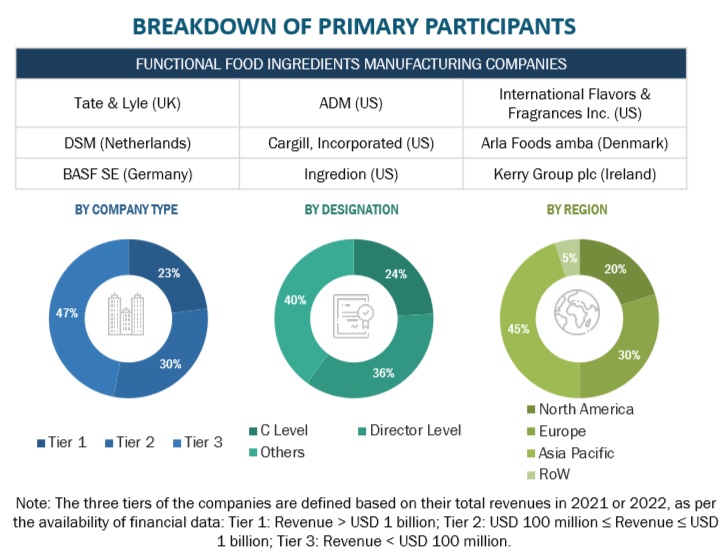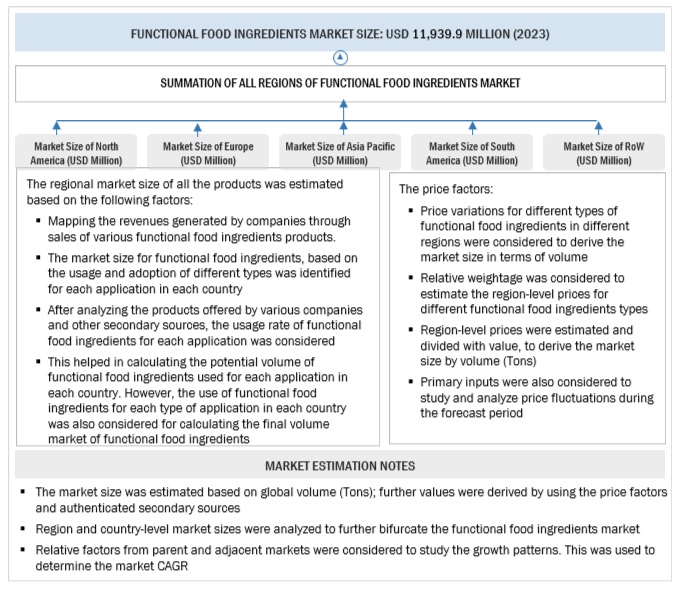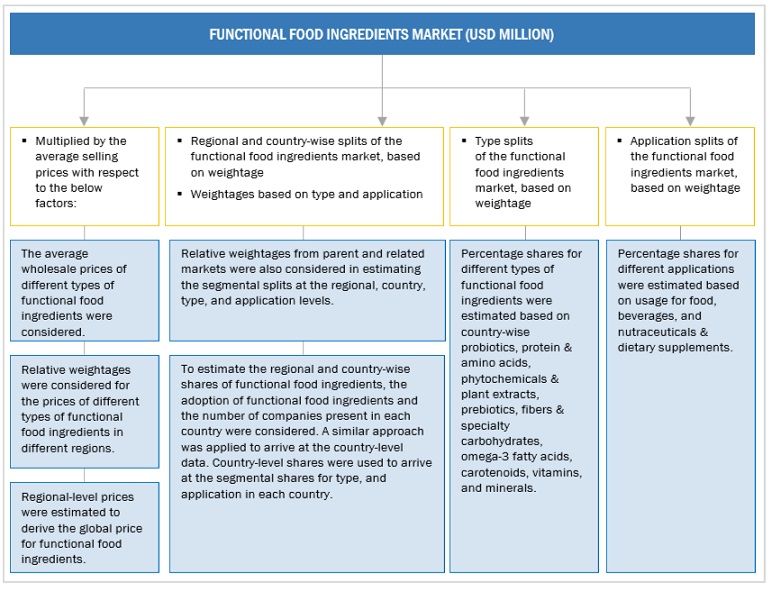The study involved two major segments in estimating the current size of the functional food ingredients market. Exhaustive secondary research was done to collect information on the market, peer, and parent markets. The next step was to validate these findings, assumptions, and sizing with industry experts across the value chain through primary research. Both top-down and bottom-up approaches were employed to estimate the complete market size. After that, market breakdown and data triangulation were used to estimate the market size of segments and subsegments.
Secondary Research
This research study involved the extensive use of secondary sources—directories and databases such as Bloomberg Businessweek and Factiva—to identify and collect information useful for a technical, market-oriented, and commercial study of the functional food ingredients market.
In the secondary research process, various sources such as annual reports, press releases & investor presentations of companies, white papers, food journals, certified publications, articles from recognized authors, directories, and databases, were referred to identify and collect information.
Secondary research was mainly used to obtain key information about the industry’s supply chain, the total pool of key players, and market classification and segmentation as per the industry trends to the bottom-most level, regional markets, and key developments from both market- and technology-oriented perspectives.
Primary Research
Extensive primary research was conducted after obtaining information regarding the functional food ingredients market scenario through secondary research. Several primary interviews were conducted with market experts from both the demand and supply sides across major countries of North America, Europe, Asia Pacific, South America, and the Rest of the World. Primary data was collected through questionnaires, emails, and telephonic interviews. The primary sources from the supply side included various industry experts, such as Chief X Officers (CXOs), Vice Presidents (VPs), Directors, from business development, marketing, research, and development teams, and related key executives from distributors, and key opinion leaders. Primary interviews were conducted to gather insights such as market statistics, data on revenue collected from the services, market breakdowns, market size estimations, market forecasting, and data triangulation. Primary research also helped in understanding the various trends related to functional food ingredients type, source, form, application, and region. Stakeholders from the demand side, such as prebiotics, probiotics, proteins & amino acids, fibers & specialty carbohydrates, vitamins, minerals, etc products manufacturers who avail the functional food ingredients services were interviewed to understand the buyer’s perspective on the suppliers, services, and their current usage of functional food ingredients and the outlook of their business which will affect the overall market.

To know about the assumptions considered for the study, download the pdf brochure
|
COMPANY NAME
|
Designation
|
|
Cargill, Incorporated (US)
|
Territory Manager
|
|
ADM (US)
|
Sales Manager
|
|
Tate & Lyle (UK)
|
General Manager
|
|
BASF SE (Germany)
|
Head of logistics department
|
|
Ingredion (US)
|
Marketing Manager
|
|
DSM (Netherlands)
|
Sales Executive
|
Functional food ingredients Market Size Estimation
Both the top-down and bottom-up approaches were used to estimate and validate the total size of the functional food ingredients market. These approaches were also used extensively to determine the size of various subsegments in the market. The research methodology used to estimate the market size includes the following details:
-
The key players in the industry and the overall markets were identified through extensive secondary research.
-
All shares, splits, and breakdowns were determined using secondary sources and verified through primary sources.
-
All possible parameters that affect the market covered in this research study were accounted for, viewed in extensive detail, verified through primary research, and analyzed to obtain final quantitative and qualitative data.
-
The research included the study of reports, reviews, and newsletters of top market players, along with extensive interviews for opinions from leaders, such as CEOs, directors, and marketing executives.
Global Functional food ingredients Market: Bottom-Up Approach.

To know about the assumptions considered for the study, Request for Free Sample Report
Global Functional Food Ingredients Market: Top-Down Approach.

Data Triangulation
After arriving at the overall market size from the estimation process explained above, the total market was split into several segments and subsegments. Data triangulation and market breakdown procedures were employed to estimate the functional food ingredients market and arrive at the exact statistics for all segments and subsegments. The data was triangulated by studying numerous factors and trends from the demand and supply sides. The market size was also validated using both the top-down and bottom-up approaches.
Market Definition
Functional food ingredients are largely defined as those ingredients that have been demonstrated to have specific physiological benefits, apart from the main nutritional benefits that are derived from food and beverages. The use of functional food ingredients in the manufacturing of functional food & beverage products is expected to provide nutritive health benefits, prevent/resist chronic diseases, or act as energy boosters.
According to the British Nutrition Foundation, “Functional food ingredients deliver additional or enhanced benefits over and above their basic nutritional value. Some functional foods are generated around a particular functional ingredient, such as probiotics, prebiotics, or plant stanols and sterols. Other functional foods or drinks can be foods fortified with a nutrient that would not usually be present to any great extent (e.g., vitamin D in milk).”
Key Stakeholders
-
Raw material suppliers
-
Functional Food Ingredients manufacturers and suppliers
-
Functional Food ingredient processors
-
Food & beverage manufacturers/suppliers
-
Commercial research & development (R&D) institutions and financial institutions
-
Importers and exporters of functional food ingredient
-
Food & beverage traders, distributors, and suppliers
-
Associations and government agencies:
-
European Communities
-
World Health Organization (WHO)
-
OECD-FAO Agricultural Outlook
-
Organizations such as the Food and Drug Administration (FDA)
-
United States Department of Agriculture (USDA)
-
European Food Safety Agency (EFSA)
-
Ministry of Food and Drug Safety (MFDS)
-
China Dood and Drug Administration (CFDA)
-
Codex Alimentarius Commission
-
Food Safety Australia and New Zealand (FSANZ)
Report Objectives
-
Determining and projecting the size of the functional food ingredients market based on source, type, form, application, and region over a five-year period ranging from 2024 to 2029.
-
Identifying the attractive opportunities in the market by determining the largest and fastest-growing segments across the key regions
-
Analyzing the demand-side factors based on the following:
-
Impact of macro- and micro-economic factors on the market
-
Shifts in demand patterns across different subsegments and regions
-
Providing detailed information about the key factors influencing the growth of the market (drivers, restraints, opportunities, and industry-specific challenges)
Available Customizations
With the given market data, MarketsandMarkets offers customizations according to company-specific scientific needs.
The following customization options are available for the report:
Service Analysis
-
Service Matrix, which gives a detailed comparison of the service portfolio of each company.
Geographic Analysis
With the given market data, MarketsandMarkets offers customizations according to company-specific scientific needs.
-
Further breakdown of the Rest of the European market for functional food ingredients into Poland, the Netherlands, Belgium, Finland, Norway, Greece, Denmark, Switzerland, and Ireland.
-
Further breakdown of the Rest of Asia Pacific market for functional food ingredients into New Zealand, Vietnam, Indonesia, Malaysia, Taiwan, and South Korea.
-
Further breakdown of the Rest of South American market for functional food ingredients into Colombia, Peru, Chile, and Venezuela.
-
Further breakdown of the Rest of the World into the Middle East (Saudi Arabia, UAE, and the Rest of the Middle East) and Africa (South Africa, Nigeria, and the Rest of Africa).
Company Information
-
Detailed analyses and profiling of additional market players (up to five)



Growth opportunities and latent adjacency in Functional Food Ingredients Market